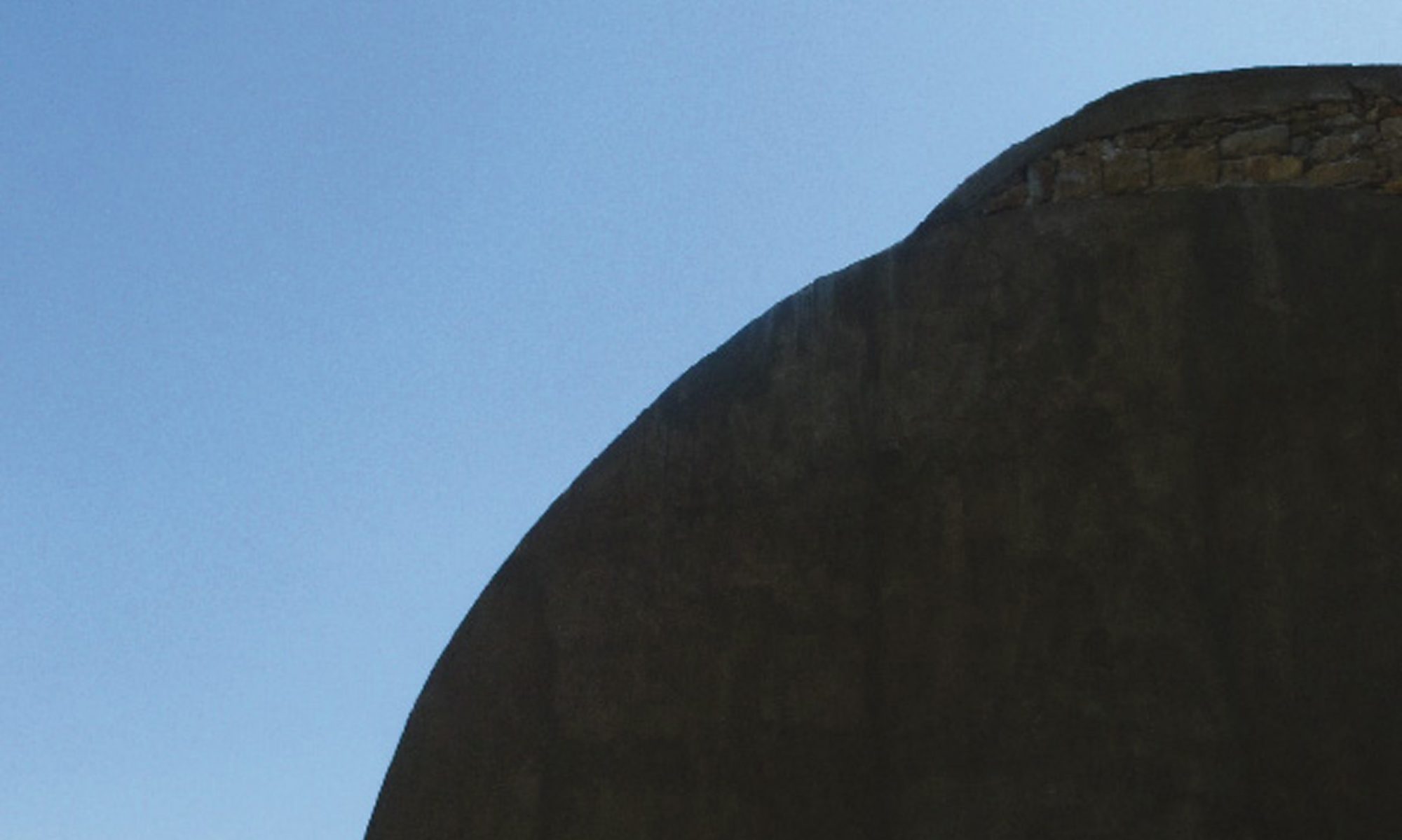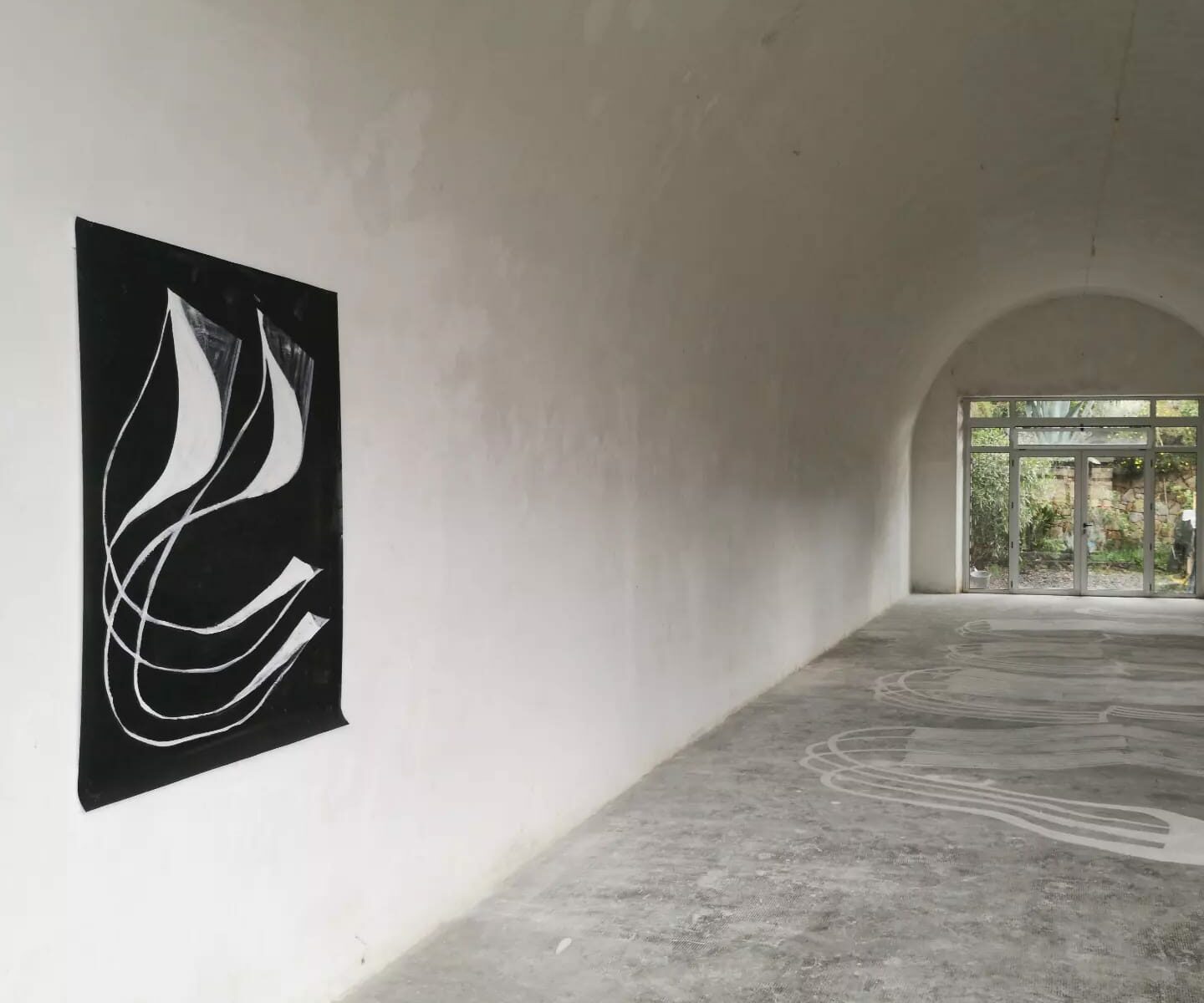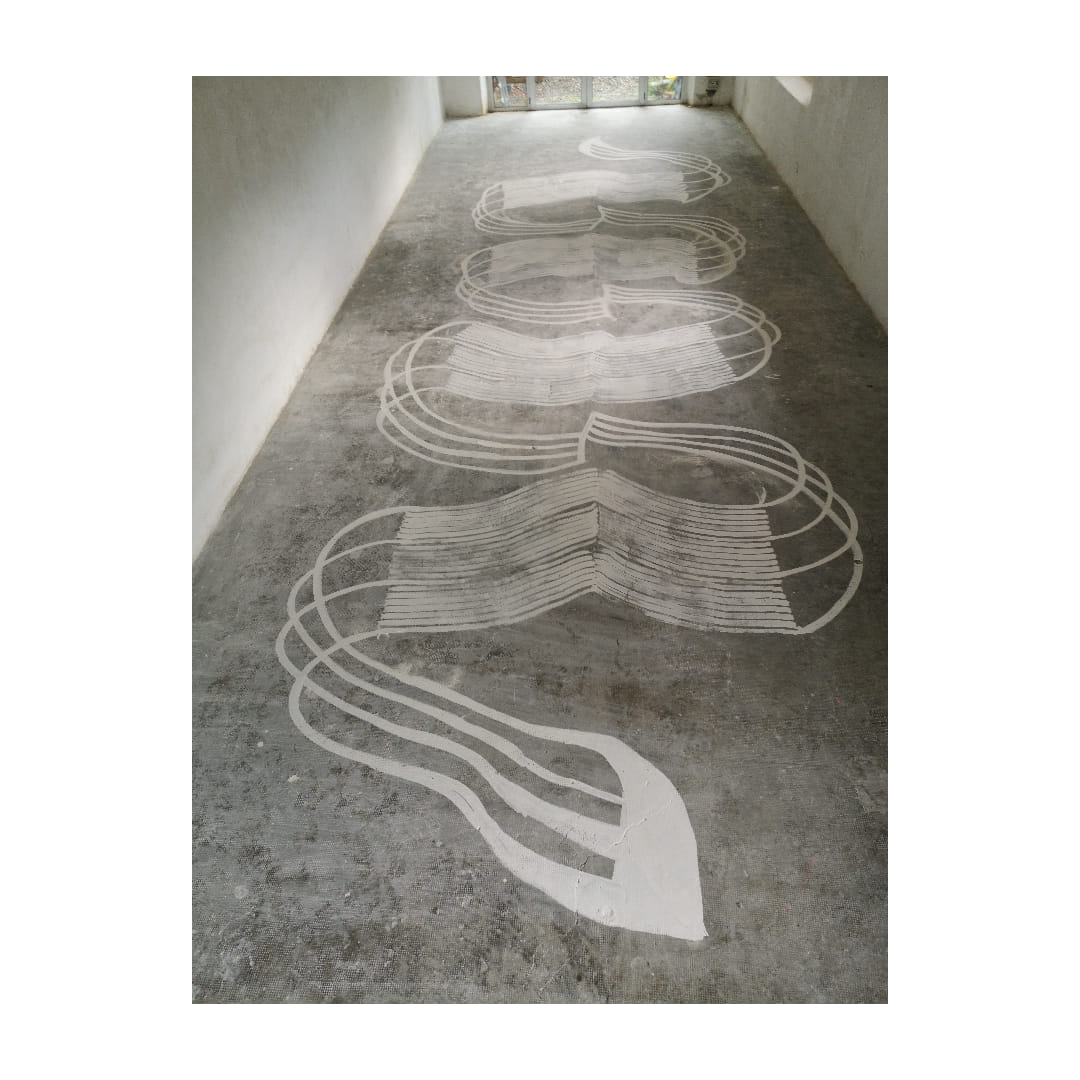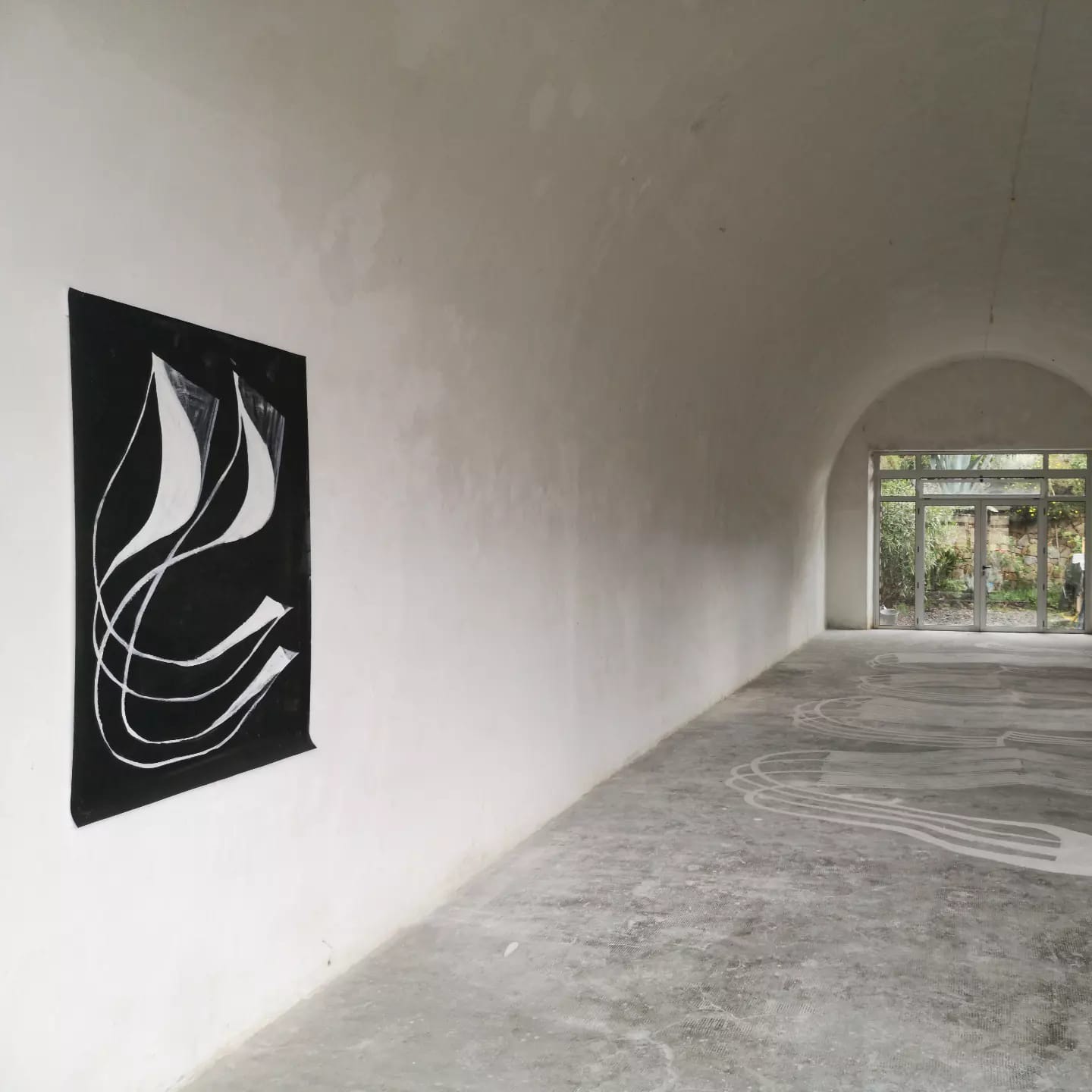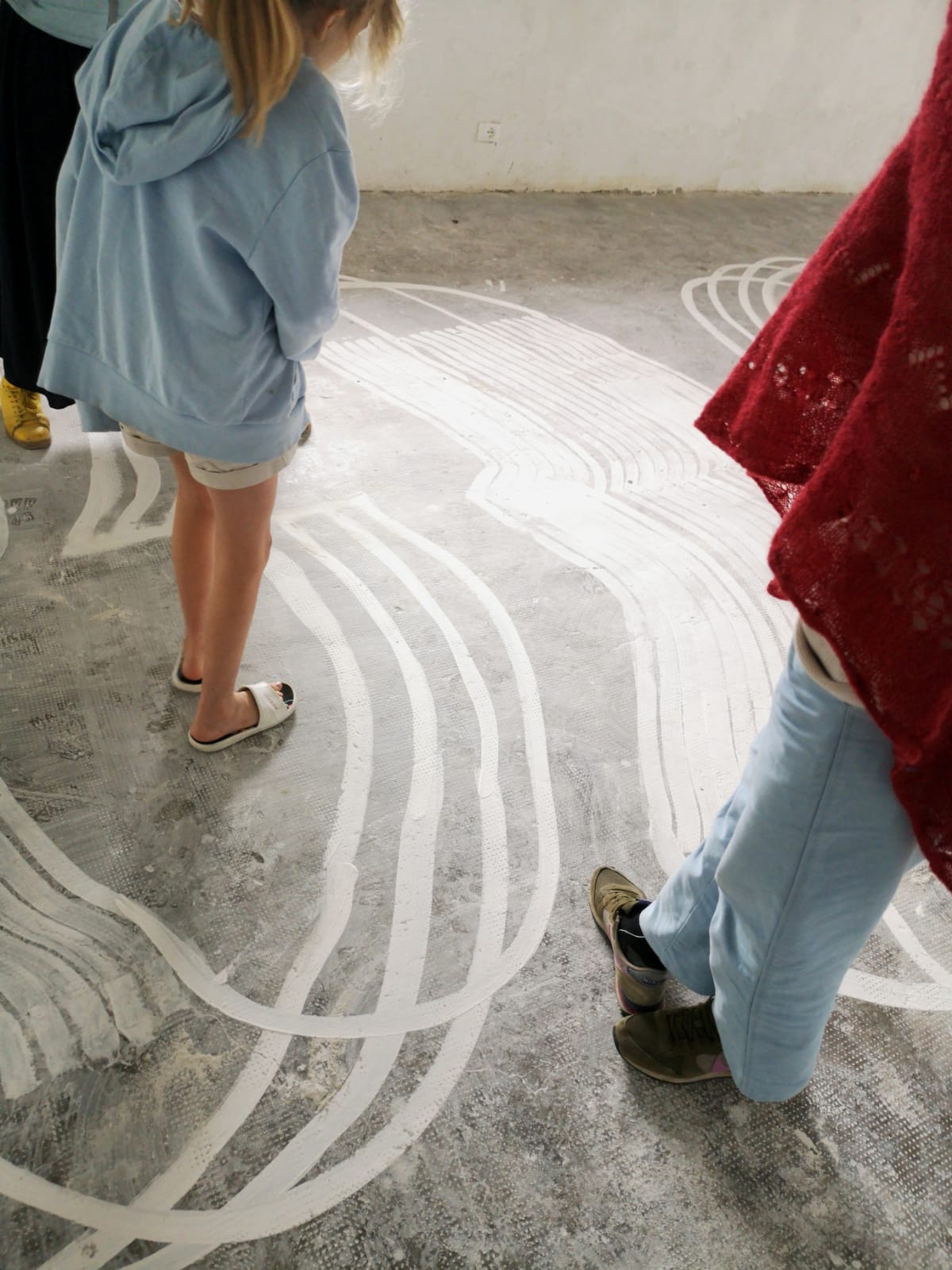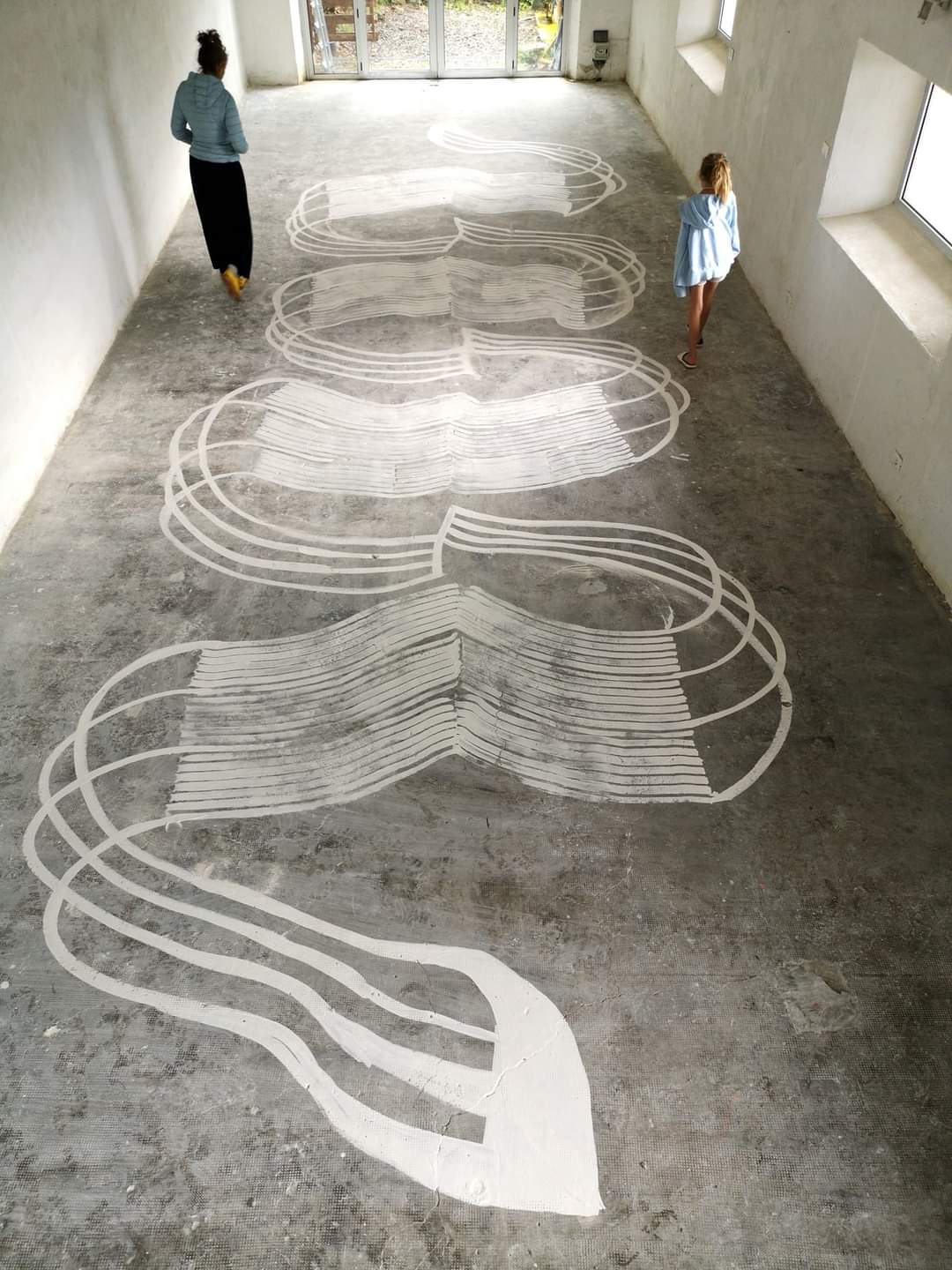Yifat Gat
20.05.2023 – 04.06.2023
Yifat Gat (born in 1969 in Israel) lives and works in the south of France. She develops an artistic work of abstract painting on canvas, paper, floors and walls. Coming from an initial training in scenography, she confronts painting with its performative and in-situ dimensions. His work has been exhibited in New York, France, Sweden, the Netherlands, London and Israel.
“Just as a screen is a window into the world of a video game, a painting is a glimpse into our creative process: where we painters are warriors, and where we score points as we grow braver , clairvoyant and free. »
Presentation of the artistic approach
My artistic practice is based on studio work. Through my research, I develop a vocabulary that allows me to use various techniques in different contexts. My universe is entirely interdependent and constantly evolving. It was Einstein who said: “All religions, arts and sciences are branches of the same tree. All these aspirations are aimed at ennobling the life of man, taking it out of the sphere of mere physical existence and leading the individual towards freedom. »
I do my best to represent this direction through my creative work, my projects for audiences and performances. My vocabulary is based on a geometry drawn by hand, imbued with a poetic humor made of repetitions and variations. Structures, vibrations and the history of our existence are the three basic elements of my vortex. I see my work as an endless mission, which I call “the process”. The works produced are like windows or holes that make this process visible and my vocation is to share it with other professionals, other artists and the public.
Yifat Gat or the vibration of the presence
Because the person does not hear much, the facility would be to hear only one or the other of the various practices of Yifat Gat. And, according to moods or tastes, retain her oils and acrylics with thick material marbled with drips or the immense “in situ” drawings during which she seems to measure the site by a meticulous rite. Or the ways of ephemeral engravings made by touching a layer of marble dust deposited on a surface. Or these black and white drawings-paintings which refer to enigmatic symbols… The critic who must classify – it is his etymological function – loses his bearings in wanting to separate each of the techniques that this artist born in Tel Aviv in 1969 and installed in France since 2007 combines and alternates with disconcerting lability. […]
This apparent multiplicity of practices deludes the observer. She hides that Yifat Gat is only looking for one thing: what vibrates. […] She lets a vibration occur, tries to bring it to the fairest, lets it express itself and evokes this kind of epiphany as an almost political project. She herself writes: “If we can note the vibration, painting can educate us in freedom. And if this is so, painting becomes a political act. The question is therefore not to represent or figure a vibration but to embody it. This vibration therefore comes from the depths of the very body of the artist, like a pulsation nourished by all these rhythms that inhabit us and interact with the universe. We find the notion of cadence which marks the relationship of the dancer to the rhythm. But this cadence would gain its inscription in each work that records it as a seismograph of being could have grasped the artist’s relationship both to the moment, to the material he rubs shoulders with, to the space he encounters. he occupies… Vibration as a carnal response to reality. This last notion escapes apprehension so much that it is necessary to multiply the nets to grasp it.
This can indeed disconcert those who only stop at one or other of the various techniques practiced by Yifat Gat, but the result is less about the appearance of what is produced than about the finesse of the apprehension of the internal vibration. This explains why she can change medium with great ease and translate an ephemeral engraving experience made in 2016 for the London fair into a new work experience on canvas. Basically, the challenge is the same: to rediscover presence. We must never overlook how much the career of this visual artist has been nourished by the relationship to theater and dance, to the presence on stage that these disciplines require. More than a visual experience, these works testify to a singular moment, specific to dancers but shared by singers and actors when they stop playing to be. It’s about being there. To vibrate in tune, echoing the world, and to make its trace as less “manufactured” as possible without depriving it of its materiality. Immense challenge always repeated, which recalls in the permanence of the artefact produced the daily miracle, which is realized when a performer enters the stage, which is always a miracle even though we do not always realize it: that of presence as the vibration of being.
– Philippe Verrièle
Yifat Gat (nato nel 1969 in Israele) vive e lavora nel sud della Francia. Sviluppa un lavoro artistico di pittura astratta su tela, carta, pavimenti e pareti. Proveniente da una prima formazione scenografica, confronta la pittura con le sue dimensioni performative e in situ. Il suo lavoro è stato esposto a New York, Francia, Svezia, Paesi Bassi, Londra e Israele.
“Proprio come uno schermo è una finestra sul mondo di un videogioco, un dipinto è uno sguardo nel nostro processo creativo: dove noi pittori siamo guerrieri e dove otteniamo punti man mano che diventiamo più coraggiosi, chiaroveggenti e liberi.»
Presentazione dell’approccio artistico
La mia pratica artistica si basa sul lavoro in studio. Attraverso la mia ricerca, sviluppo un vocabolario che mi permette di utilizzare varie tecniche in diversi contesti. Il mio universo è interamente interdipendente e in continua evoluzione. Fu Einstein a dire: “Tutte le religioni, le arti e le scienze sono rami dello stesso albero. Tutte queste aspirazioni mirano a nobilitare la vita dell’uomo, a sottrarla alla sfera della mera esistenza fisica ea condurre l’individuo verso la libertà. »Faccio del mio meglio per rappresentare questa direzione attraverso il mio lavoro creativo, i miei progetti per il pubblico e le performance. Il mio vocabolario si basa su una geometria disegnata a mano, intrisa di un umorismo poetico fatto di ripetizioni e variazioni. Strutture, vibrazioni e storia della nostra esistenza sono i tre elementi base del mio vortice. Vedo il mio lavoro come una missione senza fine, che chiamo “il processo”. Le opere prodotte sono come finestre o buchi che rendono visibile questo processo e la mia vocazione è condividerlo con altri professionisti, altri artisti e il pubblico.
Yifat Gat o la vibrazione della presenza
Poiché la persona non sente molto, la facilità sarebbe quella di ascoltare solo l’una o l’altra delle varie pratiche di Yifat Gat. E, a seconda degli umori o dei gusti, conserva i suoi olii e acrilici dalla materia spessa marmorizzata da colature o gli immensi disegni “in situ” durante i quali sembra misurare il luogo con un minuzioso rito. O i modi di incisioni effimere realizzate toccando uno strato di polvere di marmo depositata su una superficie. O questi disegni-dipinti in bianco e nero che rimandano a simboli enigmatici… Il critico che deve classificare – è la sua funzione etimologica – perde l’orientamento nel voler separare ciascuna delle tecniche che questo artista nato a Tel Aviv nel 1969 e installato in Francia dal 2007 si combina e si alterna con sconcertante labilità. […]Questa apparente molteplicità di pratiche inganna l’osservatore. Nasconde che Yifat Gat cerca solo una cosa: ciò che vibra. […] Lascia che una vibrazione avvenga, cerca di portarla al più bello, lascia che si esprima ed evoca questa sorta di epifania come un progetto quasi politico. Lei stessa scrive: “Se riusciamo a notare la vibrazione, la pittura può educarci alla libertà. E se è così, la pittura diventa un atto politico. La questione quindi non è rappresentare o figurare una vibrazione ma incarnarla. Questa vibrazione viene quindi dal profondo del corpo stesso dell’artista, come una pulsazione alimentata da tutti questi ritmi che ci abitano e interagiscono con l’universo. Troviamo la nozione di cadenza che segna il rapporto del danzatore con il ritmo. Ma questa cadenza otterrebbe la sua iscrizione in ogni opera che la registra come un sismografo dell’essere avrebbe potuto cogliere il rapporto dell’artista sia con il momento, con il materiale con cui si strofina, sia con lo spazio che incontra. occupa… Vibrazione come risposta carnale alla realtà. Quest’ultima nozione sfugge così tanto all’apprensione che è necessario moltiplicare le reti per coglierla. Questo può davvero sconcertare coloro che si fermano solo all’una o all’altra delle varie tecniche praticate da Yifat Gat, ma il risultato riguarda meno l’apparenza di ciò che viene prodotto che la finezza dell’apprensione della vibrazione interna. Ecco spiegato perché riesce a cambiare medium con grande disinvoltura e a tradurre un’effimera esperienza di incisione realizzata nel 2016 per la fiera londinese in una nuova esperienza di lavoro su tela. In fondo la sfida è la stessa: riscoprire la presenza. Non bisogna mai trascurare quanto la carriera di questo artista visivo sia stata nutrita dal rapporto con il teatro e la danza, alla presenza in scena che queste discipline richiedono. Più che un’esperienza visiva, queste opere testimoniano un momento singolare, specifico per i ballerini ma condiviso da cantanti e attori quando smettono di suonare per essere. Si tratta di esserci. Vibrare in sintonia, riecheggiare il mondo, e rendere la sua traccia il meno “fabbricata” possibile senza privarla della sua materialità. Sfida immensa sempre ripetuta, che richiama nella permanenza del manufatto prodotto il miracolo quotidiano, che si realizza quando un performer entra in scena, che è sempre un miracolo anche se non sempre ce ne accorgiamo: quello della presenza come vibrazione dell’essere .
– Philippe Verrièle
Yifat Gat (née en 1969 en Israël) vit et travaille dans le sud de la France. Elle développe un travail artistique de peinture abstraite sur toiles, papiers, sols et murs. Issue d’une formation initiale en scénographie, elle confronte la peinture à ses dimensions performatives et in-situ. Ses travaux ont été exposés à New York, en France, en Suède, aux Pays-Bas, à Londres et en Israël.
« Tout comme un écran est une fenêtre sur le monde d’un jeu vidéo, une peinture est un aperçu de notre processus de création : là où nous, peintres, sommes des guerriers, et où nous marquons des points à mesure que nous devenons courageux, clairvoyants et libres. »
Présentation de la démarche artistique
Ma pratique artistique est basée sur le travail à l’atelier. À travers mes recherches, je développe un vocabulaire qui me permet d’utiliser diverses techniques dans différents contextes. Mon univers est entièrement interdépendant et en constante évolution. C’est arbre. Toutes ces aspirations visent à ennoblir la vie de l’homme, à la sortir de la sphère de la simple existence physique et à conduire l’individu vers la liberté. »
Je fais de mon mieux pour représenter cette direction à travers mon travail de création, mes projets en direction des publics et les performances. Mon vocabulaire se fonde sur une géométrie tracée à la main, empreinte d’un humour poétique fait de répétitions et de variations. Les structures, les vibrations et l’histoire de notre existence sont les trois éléments de base de mon vortex. Je vois mon travail comme une mission sans fin, que j’appelle « le processus ». Les œuvres produites sont comme des fenêtres ou des trous qui rendent visible ce processus et ma vocation est de le partager, avec d’autres professionnels, d’autres artistes et le public.
Yifat Gat
Yifat Gat ou la vibration de la présence
Parce que la personne n’ébruite guère, la facilité serait de n’entendre que l’une ou l’autre des pratiques diverses de Yifat Gat. Et, au gré des humeurs ou des goûts, retenir ses huiles et acryliques à la matière épaisse et marbrée de coulures ou les immenses dessins « in situ » durant lesquels elle semble mesurer le site par un rite méticuleux. Ou les manières de gravures éphémères réalisées en effleurant une couche de poussière de marbre déposée sur une surface. Ou ces dessins-peintures noirs et blancs qui renvoient à d’énigmatiques symboles… Le critique qui se doit à classer – c’est sa fonction étymologique – en perd ses repères à vouloir séparer chacune des techniques que cette artiste née à Tel-Aviv en 1969 et installée en France depuis 2007 combine et alterne avec une labilité déconcertante. […] Cette apparente multiplicité des pratiques leurre l’observateur. Elle dissimule que Yifat Gat ne cherche qu’une chose : ce qui vibre. […] Elle laisse advenir une vibration, cherche à la porter au plus juste, la laisse s’exprimer et évoque cette manière d’épiphanie comme un projet quasiment politique.
Elle-même en écrit : « Si nous pouvons noter la vibration, la peinture peut nous éduquer à la liberté. Et si c’est ainsi, la peinture devient un acte politique. » La question n’est donc pas de représenter ou de figurer une vibration mais de l’incarner. Cette vibration vient donc du plus profond du corps même de l’artiste, comme une pulsation nourrie de tous ces rythmes qui nous habitent et interagissent avec l’univers. On retrouve la notion de cadence qui marque le rapport du danseur au rythme.
Mais cette cadence gagnerait son inscription dans chaque œuvre qui l’enregistre comme un sismographe de l’être aurait pu saisir la relation de l’artiste à la fois à l’instant, à la matière qu’il côtoie, à l’espace qu’il occupe… La vibration comme réponse charnelle au réel. Cette dernière notion échappe tant à l’appréhension qu’il faut multiplier les rets pour la saisir.
Ce qui peut effectivement déconcerter celui qui ne s’arrêterait qu’à l’une ou l’autre des techniques diverses que pratique Yifat Gat, mais le résultat y tient moins à l’apparence de ce qui est produit que dans la finesse de l’appréhension de la vibration interne. C’est ce qui explique qu’elle puisse changer de médium avec une grande facilité et traduire une expérience de gravure éphémère réalisé en 2016 pour la foire de Londres en nouvelle expérience de travail sur toile. Dans le fond, l’enjeu est le même : retrouver la présence.
Il ne faut jamais négliger combien le parcours de cette plasticienne a été nourrie de la relation au théâtre et à la danse, à la présence en scène que ces disciplines supposent. Plus que d’une expérience plastique, ces œuvres témoignent d’un moment singulier, propre aux danseurs mais que partagent chanteurs et acteurs quand ils cessent de jouer pour être.
Il s’agit d’être là. De vibrer juste, en écho au monde, et d’en rendre la trace la moins « fabriquée » possible sans lui ôter de sa matérialité. Immense défi toujours recommencé, qui rappelle dans la permanence de l’artefact produit le miracle quotidien, qui se réalise quand un interprète entre en scène, ce qui est toujours un miracle quoi que l’on ne s’en rende pas toujours compte : celui de la présence comme vibration de l’être.
Philippe Verrièle
